
Mycalesis oculus, the red-disc bushbrown, is a satyrine butterfly found in southern India. It is similar in markings to Mycalesis adolphei but distinguished by the reddish band around the large apical spots on the upper forewings.
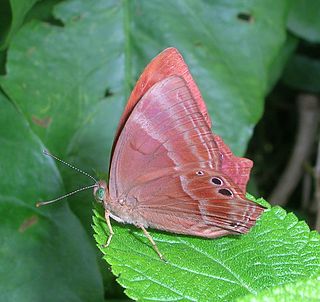
Abisara echerius, the plum Judy, is a small but striking butterfly found in Asia belonging to the Punches and Judies family (Riodinidae). It is difficult to distinguish it from Abisara bifasciata.

Mycalesis anaxias, the white-bar bushbrown, is a species of satyrid butterfly found in South and Southeast Asia. In South Asia, it inhabits Sikkim, eastwards through the hill-ranges to Assam, Cachar, Myanmar and Tenasserim. Also in southern India, in the Nilgiris and Travancore.
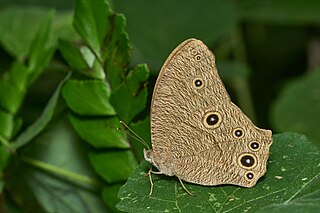
Melanitis leda, the common evening brown, is a common species of butterfly found flying at dusk. The flight of this species is erratic. They are found in Africa, South Asia and South-east Asia extending to parts of Australia.
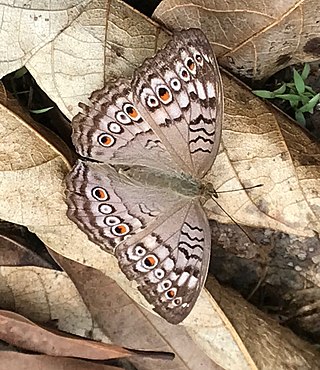
Junonia atlites, the grey pansy, is a species of nymphalid butterfly found in South Asia.

Mycalesis perseus, the dingy bushbrown or common bushbrown, is a species of satyrine butterfly found in south Asia and southeast Asia.

Mycalesis mineus, the dark-brand bush brown, is a species of satyrine butterfly found in Asia.

Mycalesis subdita, the Tamil bushbrown, is a satyrine butterfly found in south India and Sri Lanka. It is not resolved whether this is a good species or is a subspecies of Mycalesis visala.
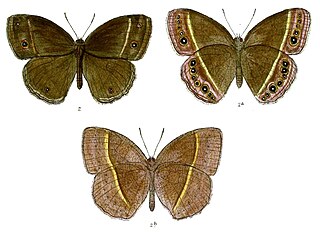
Mycalesis (annamitica) lepcha, the Lepcha bushbrown, is a satyrine butterfly found in Asia. It is not resolved whether it is best considered a distinct species, or included in Mycalesis annamitica. It was formerly included in Mycalesis malsara.
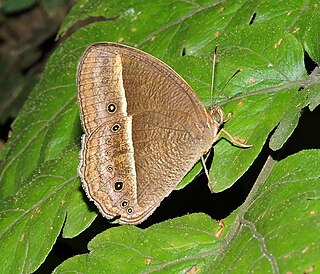
Mycalesis nicotia, the brighteye bushbrown, is a species of satyrine butterfly found in Asia.
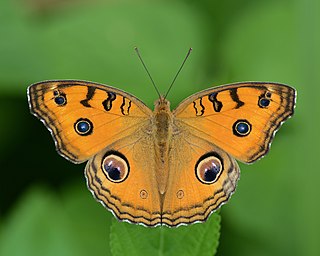
Junonia almana, the peacock pansy, is a species of nymphalid butterfly found in Cambodia and South Asia. It exists in two distinct adult forms, which differ chiefly in the patterns on the underside of the wings; the dry-season form has few markings, while the wet-season form has additional eyespots and lines. It is listed as Least Concern in the IUCN Red List.

Ypthima baldus, the common five-ring, is a species of Satyrinae butterfly found in Asia.

Ypthima chenu, the Nilgiri fourring, is a species of Satyrinae butterfly found in south India.

Ypthima huebneri, the common fourring, is a species of Satyrinae butterfly found in Asia.

Melanitis phedima, the dark evening brown, is a species of butterfly found flying at dusk. The flight of this species is erratic. They are found in south and southeast Asia.

Vindula erota, the common cruiser, is a species of nymphalid butterfly found in forested areas of tropical South Asia and Southeast Asia.

Junonia iphita, the chocolate pansy or chocolate soldier, is a butterfly found in Asia.
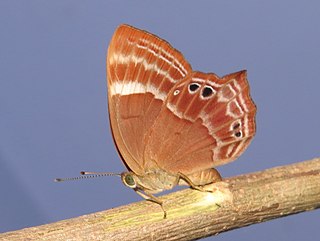
Abisara bifasciata, the double-banded Judy or twospot plum Judy, is a butterfly in the family Riodinidae. It is found in Asia.

Ypthima sakra, the Himalayan five-ring, is a butterfly in the family Nymphalidae native to Asia.

Callerebia dibangensis, the Roy’s argus or bright-eyed argus is a species of Satyrinae butterfly found in eastern Himalaya, India.




















